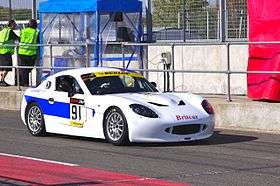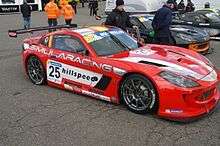Ginetta Cars
|
| |
| Private | |
| Industry | Automotive |
| Founded | 1958 |
| Founders |
|
| Headquarters | Leeds, West Yorkshire, United Kingdom |
Key people | Lawrence Tomlinson, Chairman |
| Products | Sports cars |
| Parent | LNT Group |
| Website | Ginetta.com |
Ginetta Cars is a British specialist builder of racing and sports cars based in Garforth, Leeds, West Yorkshire.
History
20th century
Ginetta was founded in 1958 by four Walklett brothers (Bob, Ivor, Trevers and Douglas) in Woodbridge, Suffolk. Their first product, the Fairlight, was a glass-fibre body shell priced at £49 for fitting to a Ford 8 or 10 hp chassis.[1] The first car, not destined for production, which subsequently became known as the Ginetta G1, was based on a pre-war Wolseley Hornet six.[2]
The four Walklett brothers each had their areas of expertise. Bob was the Managing Director, Douglas was mechanical engineer and electrics, Ivor the designer and Trevers was styler working closely with Ivor.
From their original base, the company moved to Witham, Essex, in 1962, and between 1972 and 1974 operated from larger premises in Ballingdon Street adjacent to the railway bridge Sudbury, Suffolk, before returning to Witham. In 1988, the Walklett brothers needed bigger premises and so moved the company to Scunthorpe where they could expand. On 7th November 1989 the Walklett's sold Ginetta to an international group of enthusiasts, based in Sheffield and run by managing director Martin Phaff. Ginetta were in a strong financial position and the Walklett's went on to retire.
Under the new managing director, Martin Phaff the company went on to produce the Ginetta G20 and the Ginetta G33. Unfortunately, it was during this time that the company hit troubled times.
21st century
In late 2005 Ginetta was acquired by LNT Automotive, a company run by racing driver, engineer and businessman Lawrence Tomlinson. His aims were in line with the founders; to produce innovative, capable, great value sports cars.
In mid-2007 Ginetta moved to a factory near Leeds, with a target to sell 200 cars a year. Tomlinson himself penned the base specification for the Ginetta G50, which marked 50 years of Ginetta production and became a successful GT4 car.
In March 2010, Ginetta acquired the Somerset-based sports car manufacturer Farbio, and re-badged their car as the Ginetta F400. In March 2011, Ginetta launched the G55, running in the Michelin Ginetta GT Supercup and built to the GT3 class regulations. In October 2011 Ginetta launched the G60, a two-door mid-engined sports car developed from the F400 and powered by a Ford-sourced 3.7-litre V6 engine.[3]
Models
Models produced by Ginetta include the following:
G2
Ginetta's first car, the G2, was produced as a kit car for enthusiasts and consisted of a tubular frame chassis to take Ford components and aluminium body. About 100 were made.
G3 and G4
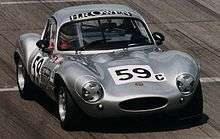
The G3 was introduced with a glass fibre body in 1959 to be followed by the G4 in 1961.[4]
The G4 used the new Ford 105E engine and had a glass fibre GT-style body along with the suspension updated to coil springing at the front with a Ford live axle at the rear. Whereas the G2 and G3 had been designed for competition, the G4 was usable as an everyday car but still was very competitive in motor sport with numerous successes. In 1963, a coupé variant was introduced alongside the open top variant and a BMC axle replaced the Ford unit at the rear.[5] In testing, the car reached 120 mph (190 km/h) with a 1,500 cc engine.[6] The series III version of 1966 added pop-up headlights. Production stopped in 1968 but was revived in 1981 with the Series IV which was two inches wider and three inches (76 mm) longer than the III. Over 500 were made up to 1969 with a variety of Ford engines.
G10, G11 and G12

Launched at the 1965 Racing car show, the Ginetta G10 was meant to be a more powerful racing car than it's predecessors. Weighing around 900 kg (1,984 lb) and fitted with a 289 cu in (4.7 L) V8 engine from the Ford Mustang, it was well received by the enthusiasts. Ginetta works driver Chris Meek secured a win with a prototype at the car's debut at Brands Hatch, beating a Jaguar E-Type which was considered to be the most successful GT racing car. However Ginetta failed to make a homologated version of the G10 in order for it to keep competing and as a result, it was forced out of the competition with a total production of only three cars. Following the reception the G10 had generated, Ginetta produced the G11, a street legal version of the G10 with the same body but with the Ford V8 replaced by the MGB 1800 engine. However, slow deliveries of the engine curbed production of the car and therefore only a handful were made.[7]
Unveiled in 1966, the G12 was an evolution of the G4 but featured many new features that made it stand apart from its predecessors. The car featured a new tubular steel space frame chassis along with the cock pit section mounted to it for extra strength while removable body work allowed for easy repair. The front suspension consisted of Triumph-derived uprights and double wishbones (with camber adjustment courtesy of rose-joints on the upper items) and coil springs. While at the rear, the usual arrangement of single upper transverse links with lower reversed wishbones (with rose-joints) and radius arms was present along with coil springs. The car was fitted with anti-roll bars for increased safety and the while Triumph sourced Girling disc brakes at the front and rear ensured increased stopping power. Power came from a 1-litre Cosworth SCA Inline-4 engine, though larger engines were fitted later such as an Aston Martin V8 but were less successful. The G12 dominated the competition in its class, outclassing Lotus Elan 26Rs and Coventry Climaxes winning the 1,150cc MN series. Outside track racing, the G12 found success at hill climb events as well, before it was replaced by the G16. Approximately 28 were built.[8]
G15
In 1967 the G15, utilizing a rear-mounted 875 cc Sunbeam Imp engine, was launched.[9] This two-seat coupé had a glass fibre body bolted to a tube chassis and used Imp rear and Triumph front suspension. Approximately 800 were produced from 1967 to 1974 [9] and the car was fully type approved allowing for complete Ginetta cars to be sold for the first time. Eight G15s were produced with Volkswagen engines and called "Super S".
G21
In 1970, the G15 was joined by the larger G21, which was initially available with either a 2.0-litre Ford Kent engine, or a 3.0-litre Ford Essex V6 engine. The car largely used Rootes components.[10] The 1.7-litreSunbeam Rapier engine subsequently became the standard four-cylinder engine for the car. 80 cars in total were produced before production ceased in 1974 due to the oil crisis. The car was later morphed into an open top G23 and G24 coupé version but none of those variants went to production.
G19
The G19 was a single seater Formula 3 racing car of which only one was produced.
G20
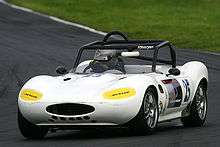
G26, G27, G28, G30 and G31
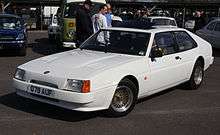
Following reorganisation the company moved to Scunthorpe and started making cars in kit form again in the 1980s starting with the G27 and followed by the G26, G28, G30 and G31, with all cars using Ford parts.
- Ginetta G26
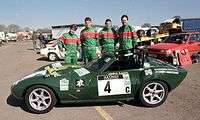 Ginetta G27 Series 3
Ginetta G27 Series 3
G32 and G33
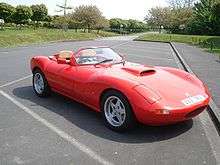
It was decided to re-enter the complete car business with the mid-engined G32 with a choice of 1.6- or 1.9-litre four-cylinder engine, available as a coupé or convertible and the G33 convertible with 3.9-litre Rover V8 capable of 145 mph (233 km/h) and a 0-60 mph time of 5 seconds. In 1990 the G32 coupé cost £13,700, the convertible £14,600, and the G33 £17,800.
G4 Series IV
.jpg)
The G4 was re-introduced in 1981 as the G4 Series IV, with a new chassis.[11] It was produced through to 1984 with approximately 35 examples built.[11] The Series IV was powered by a 1,599 cc Ford four-cylinder engine.[12]
G50
After Ginetta was acquired by Lawrence Tomlinson in 2005, the company began work on the design of the Ginetta G50 - a 3.5-litre V6 engine, producing 300 BHP - to celebrate the company's 50th anniversary. In 2007, the car competed in its first race in the European GT4 Cup, in Nogaro France, finishing second.
Soon after this success, the machine was officially launched at Autosport International in early 2008 alongside its sister car, the Ginetta G50 GT4. Together, they have become Ginetta’s best selling machines, and have race wins that include the Dubai 24 Hour endurance race in 2012 with Optimum Motorsport.
G60
In March 2010, Lawrence acquired the Somerset-based sports car manufacturer Farbio, and in doing so inherited the F400, which was subsequently redesigned, redeveloped and rebranded from the Farbio Marque, into the Ginetta G60; a two-door mid-engined sports car which shares the same 3.7-litre V6 engine as its G55 GT3 stablemate and is capable of 0 – 60 mph in 4.9 seconds, with a top speed of 165 mph.
G40
In 2010, Lawrence implemented a newer, safer car into the existing Ginetta Junior series and in doing so, replaced the old Ginetta G20 race car with a G40J.
Following the success of the G40J, Ginetta decided to introduce a Ginetta G40 Challenge car for the adult racers in its Challenge series. With the same engine as its sister car, the G40 Challenge car is capable of 165 bhp and competes against existing G20 models. Today, the car features heavily in the Total Quartz Ginetta GT5 Challenge.
Ginetta unveiled its second road car - the Ginetta G40R - in 2011, designed to mimic the Walklett brothers' original vision of 'a race car for the road'. Capable of 0-60 in 5.8 seconds, the G40R shares a number of characteristics with its racing siblings.
G55
2011 saw the introduction of the G55 Cup car to the Ginetta GT Supercup, which, until that point, had only featured the G50 Cup car. Offering a 3.7-litre V6 engine with 380 BHP, the car provided Ginetta with the basis for their Ginetta G55 GT3 car; a larger spec machine which gives GT teams a 4.35L V8 powerplant.
Motorsport
Michelin Ginetta GT4 SuperCup
The Michelin Ginetta GT4 SuperCup is a single-class race series which features both the Ginetta G50 and G55 sports cars; running in support of the British Touring Car Championship.
The championship began as the Ginetta G50 Cup in 2008, supporting the British Formula Three Championship and British GT Championship. In 2009 it moved to support the BTCC. In 2011, with the introduction of the Ginetta G55, the championship became the Michelin Ginetta GT4 SuperCup.
The 2014 season will be the fourth running of the Michelin Ginetta GT4 Supercup, but it will be the first year in which the G50 GT4 and G55 GT4 cars are consolidated into one single class. In order to maintain fair competition, the two models will be equalised through a balance of performance test.
Protyre Motorsport Ginetta GT5 Challenge
The Protyre Motorsport Ginetta GT5 Challenge offers a unique, low-cost opportunity to race in a single-make racing championship, over seven race weekends supporting the British GT package. For 2014, the series will once again return to Spa for an international round alongside the Swedish Ginetta Challenge series.
A popular entry-level championship for many GT racers, the series boasts packed grids with close racing. All weekends are triple headers, providing 21 races throughout the season, with all races counting towards the final championship positions.
Prototype
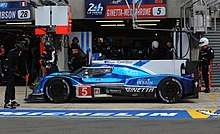
Ginetta supplies customer LMP3 cars for the European Le Mans Series and Asian Le Mans Series as well as the IMSA Prototype Challenge.
In 2017 Ginetta developed a LMP1 class car the Ginetta G60-LT-P1.[13] For the 2018–19 FIA World Endurance Championship season Ginetta entered 2 G60-LT-P1 in the WEC series in conjunction with TRSM Racing Manor. At the 2018 24 Hours of Le Mans, the #5 car finished 5th in class, while the #6 car retired after 10 hours due to persistent electrical issues. [14]
See also
References
- ↑ Car Mechanics magazine advert. 1959.
- ↑ Georgano, N. (2000). Beaulieu Encyclopedia of the Automobile. London: HMSO. ISBN 1-57958-293-1.
- ↑ "Ginetta G60 (2011) CAR review". Car Magazine. 21 October 2011. Retrieved 21 October 2011.
- ↑ For road test see Motor Sport, September 1962, Pages 690, 693.
- ↑ Motor Sport, May 1963, Pages 345-346.
- ↑ Motor Sport, April 1964, Pages 260-261.
- ↑ https://www.dkeng.co.uk/press/1451909267-94fe01c5a552f5a3b1ba64b0dcd53506.pdf%7CGinetta G10 and G11
- ↑ "Ginetta G12". Motorsport Magazine. October 2008. Retrieved 29 May 2018.
- 1 2 Michael Sedgwick & Mark Gillies, A-Z of Cars 1945-1970, page 82
- ↑ "Motor Show Number: Car by Car Guide and Ginetta advertisement". Motor. nbr 3565: Pages 21 & 175. 17 October 1970.
- 1 2 Peter Higston, The Enthusiasts' Guide to Buying a Classic British Sports Car, 2007, page 60
- ↑ John Blunsden, The Observer's Book of Automobiles, Twenty-fifth Edition, 1982, page 92
- ↑ http://sportscar365.com/lemans/wec/ginetta-announces-lmp1-chassis-for-2018/
- ↑ "Ginetta LMP1 a solid building block for ManorDriver line up". Motorsports.com. 2 July 2018. Retrieved 5 July 2018.
Bibliography
- Walklett, Bob (1994). Ginetta - The Inside Story: 31 Years of British Specialist Car Manufacturer. Bookmarque Publishing. ISBN 1-870519-28-0.
- Rose, John (1988). Ginetta: The Illustrated History. G T Foulis & Co Ltd. ISBN 0-85429-685-9.
- Pyman, T (2004). History of the Ginetta G4. Bookmarque Publishing. ISBN 1-870519-69-8.
External links
| Wikimedia Commons has media related to Ginetta vehicles. |
_-_14850409248.jpg)
.jpg)
